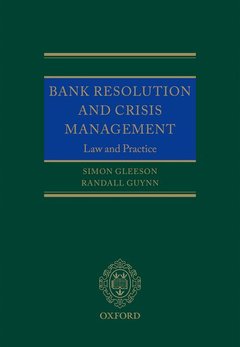Description
Bank Resolution and Crisis Management
Law and Practice
Authors: Gleeson Simon, Guynn Randall
Language: English
Publication date: 03-2016
358 p. · 18.6x24.7 cm · Hardback
Out of Print
358 p. · 18.6x24.7 cm · Hardback
Out of Print
Description
/li>Biography
/li>
The 2008 global financial crisis ushered in the biggest explosion in new bank regulation around the world since the Great Depression. Even more so than then, this new regulation has been coordinated on a global basis and reflects global standards as well as local idiosyncracies. Although governments and regulators have sought to put measures in place to prevent the failure of banks, they have acknowledged the need for measures to address what happens when banks fail or are threatened with failure and how to resolve such failure. Bank Resolution and Crisis Management: Law and Practice deals with the measures which European, U.S. and international law and policy makers have sought to put in place to deal with the threat of financial institutions failing, including enhanced supervision, early intervention and so called 'living wills'. Measures such as 'bail-out' (protecting private shareholders and creditors against losses) and 'bail-in' (imposing losses on shareholders and long-term creditors without causing contagion among short-term creditors) are discussed. The work includes comprehensive summaries and commentary on the EU Bank Recovery and Resolution Directive, the UK resolution laws including the Banking Act 2009 and amendments to that act, the Orderly Liquidation Authority under Title II of the U.S. Dodd-Frank Act, proposed new Chapter 14 to the U.S. Bankruptcy Code, and the bank resolution provisions of the U.S. Federal Deposit Insurance Act. The book also provides detailed commentary on the provisions in the Banking Act 2009 dealing with resolution, including discussion of the stabilisation, bank administration and insolvency powers. This includes analysis of secondary legislation such as the Partial Transfers Order. Special emphasis is given to the practical effect of such measures on financial transactions and their impact on arrangements, such as netting and set-off. There is also commentary on the Financial Services Investor Compensation Scheme and its role in returning money to the depositors in a failing bank. The special position of failing investment banks is also a feature of the book. Coverage includes analysis of the legislation adopted to address the particular issues that arose in the failure of Lehman Brothers and the resulting litigation, particularly that relating to the recovery of client assets. This work will be invaluable for regulatory, transactional and insolvency lawyers and other professionals advising banks on their powers and governance processes, in structuring and documenting transactions and in dealing with banks in the course of insolvency proceedings.
Simon Gleeson is a partner at Clifford Chance specializing in financial markets and banking law and regulation, clearing, settlement and derivatives. He advises governments, regulators and public bodies as well as banks, investment firms, fund managers and other financial institutions on a wide range of regulatory issues. He has been a member of the Financial Markets Law Committee, chairs the Institute of International Finance's Committee on Cross-Border Bank Resolution, has written numerous books and articles on financial regulation, He is a Visiting Professor of the Faculty of Law at the University of Edinburgh. Simon is the author of International Regulation of Banking, 2e (2012: OUP) as well as having being the author of A Practitioner's Guide to the FSA Regulation of Investment Banking (2006:City and Financial Publishing). Randall Guynn is head of Davis Polk's Financial Institutions Group. He is widely recognized as one of the United States' leading bank regulatory and bank M&A lawyers, and a thought leader on financial regulatory reform. He was named the Banking Lawyer of the Year and the most highly regarded banking lawyer in the world in 2014 by Law Business Research's International Who's Who of Banking Lawyers and one of the 10 most innovative lawyers in the United States by the Financial Times in 2013. Randall is co-author of Debt Restructuring (2011: OUP, 2e forthcoming 2016).
© 2024 LAVOISIER S.A.S.
These books may interest you

Debt Restructuring 352.72 €



